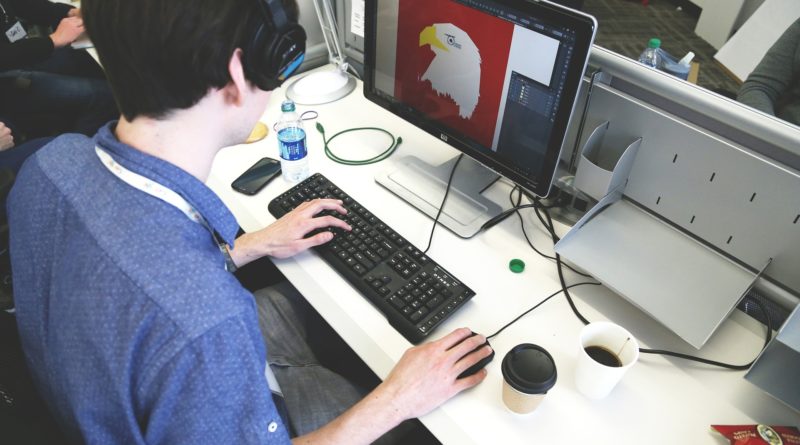The 5 Best Laptops For Photoshop 2025
So, it’s pretty much a given that Photoshop is the most popular and useful software for image editing—it’s the go-to choice for a reason. But when it comes to figuring out what laptop specs you actually need to run it well? That’s where things get messy.
The problem? There’s a ridiculous amount of conflicting advice out there about what hardware works best for Photoshop.
Here’s what usually happens:
- Option A: People blow their budget on some overpowered, 10lb beast of a laptop with features they’ll never fully use.
- Option B: Others cheap out and grab a $200 potato that struggles to handle more than a dozen layers without a meltdown.
The reality? The hardware you need (and how much you should spend) depends entirely on how you’re using Photoshop—and yeah, your skill level plays a role too.
“Wait…does that mean buying a laptop is complicated?”
Not really, and that’s where I come in.
Sure, I could just tell you what to buy, but that’s what every other so-called “expert” site does. They throw out random laptop lists without explaining the price tags or why those models might actually work for you.
Here’s what I’m gonna do instead:
I’ll break it all down in simple terms, using:
- My own years of Photoshop experience.
- The latest 2025 benchmark data from Puget Systems and other reliable sources.
And yeah, I’ll also give you a list of laptops (because I know some of you just want quick answers). For each one, I’ll explain:
- Whether it’s suited for beginners, intermediates, or pros.
- The type of user who’ll benefit most—photographers, graphic designers, web designers, bloggers, etc.
- The kind of editing it’s good for—basic cropping, high-res image editing, pixel-perfect precision, you name it.
But before we dive into specific laptops, let’s go over the essential specs everyone should focus on. Trust me, understanding this will save you from wasting money or buying something that can’t keep up.
Recommended Laptop Specs for PhotoShop
If you have trouble keeping up with the jargon coming next, read my guide: Beginner’s Guide to Computer Specifications First.
RAM
RAM determines how many layers, tabs, and large files your laptop can handle without slowing down.
16GB: The sweet spot for photographers, web designers, and general users. It will give your iGPU a nice boost as well.
8GB: Works for beginners or light photo edits but may struggle with heavy multitasking.
32GB: Ideal for power users handling massive files or running Photoshop alongside other resource-heavy apps.
CPU
When picking a CPU for photoshop you want to focus on single-clock speed (not # of cores) as shown here editing tasks are mostly single thread.
It’s not necessary to get the latest. A modern Core i5 will suffice for most users. Anything extra (Ryzen 7 or Core i7) should only be used when:
- Working with large, high-resolution images (300+ DPI), gigabyte-sized files, or hundreds of layers.
- Multitasking with other heavy software.
- Speed up AI based effects & processes.
Storage
Photoshop benefits greatly from fast storage for opening files, saving projects, and using scratch disks. However, most laptops now have SSDs and regardless of generation or type, they all have the same speed for most purposes.
If you however are a photographer and need to import a large amount of photos back and forth, invest on PCIe NVMe 5.0 the fastest for reading/writing data.
Display
This MAy or MAY NOT be important but as a bare minimum you want a 15” FHD IPS display (most laptops will have this if you spend more than 500 bucks).
Type: I have a detailed post on laptop displays and on other “premium” displays that may give you better “color accuracy” important for extremely color accurate PHOTO editing.
Resolution: Ideally you want QHD but that’s kind of expensive. QHD not only gives you a much larger canvas but usually better color reproduction as well.
GPU (Graphics Card)
Top 5 Best Laptops for Photoshop
If you need a detailed explanation of why I chose the following laptops or have any other questions, check out the guide at the end. These laptop recommendations have been updated as of early 2025
1. Lenovo Ideapad 5i
Best Budget Laptop For Photoshop
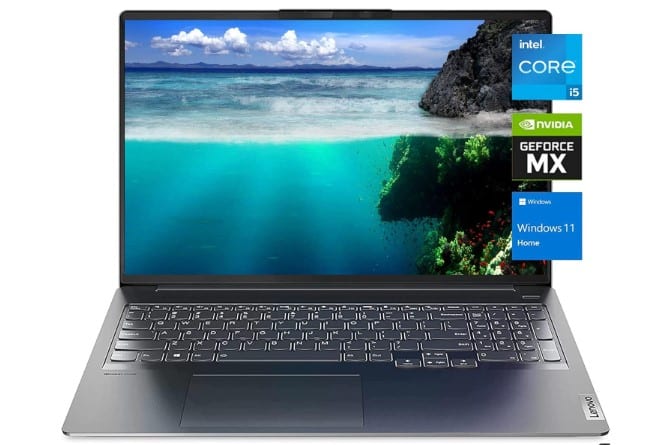
Intel Core i5-11300H
8GB DDR4
GeForce MX 450 2GB vRAM
512GB PCIe 4.0 SSD
16″ QHD 2.5K
4.2 lbs
4 hours
Alright, so this laptop is in a whole different league compared to the entry-level stuff we talked about earlier. It’s got dedicated graphics and a QHD display, all for just about $100 more. If you’re serious about Photoshop but don’t wanna nuke your wallet, this is a solid pick.
GPU: Why the MX450 Still Slaps in 2025 for Photoshop
Here’s the thing: if you’re editing big files, running crazy layer effects, or using GPU-heavy stuff like neural filters, you’re gonna want dedicated graphics. Even a 2GB vRAM GPU like the MX450 makes a world of difference compared to integrated graphics.
Integrated GPUs like RX Vega 7 and Intel Xe? They’re fine for light edits, but they’ll start choking on bigger projects. Even if you max out shared RAM to 16GB, they just can’t keep up with the raw power of a dGPU. And let’s be real—finding newer GPUs like the Intel Arc A370M or MX550 for under $800 is basically a pipe dream. At this price (~$600), the MX450 still holds its own in 2025.
What About Bigger GPUs?
Yeah, you could go for something like an RTX 2050 or a GTX 1650 in this price range, but here’s the catch: they don’t come with a display like this. For Photoshop, having a great screen matters just as much (if not more) than raw GPU power. And that’s where this laptop wins.
Display: QHD Resolution, 16” IPS Panel
Here’s where this laptop flexes on the competition. Most budget laptops with dGPUs are stuck with FHD resolution (1920×1080) and tiny 15-inch screens. Meh. This one? QHD (2560×1440) on a 16-inch IPS panel. It’s a big upgrade.
Why does this matter? Because more resolution = more screen real estate. You can have your Photoshop canvas, layers, tools, and adjustments all open at the same time without feeling like you’re working on a postage stamp. Plus, the extra pixels make everything sharper and clearer, so you’re not second-guessing your edits.
More space = less zooming, less scrolling, and way more productivity. Simple.
Storage & RAM: Could Be Better, But It Works
- RAM: You’re stuck with 8GB, and it’s not upgradeable. Yeah, not ideal, but thanks to the dGPU, it’s not as big of a deal as you’d think. Unless you’re working on massive multi-gigabyte projects with 100+ layers, 8GB will hold up just fine.
- Storage: 512GB PCIe SSD. Plenty of space for Photoshop files since most of them don’t even crack a gigabyte. If you ever run out, you can swap the SSD for a bigger one.
Form Factor: Surprisingly Portable
For a 16-inch laptop, this thing is surprisingly easy to lug around. At 4.2 lbs, it’s not exactly ultrabook-light, but it’s still super manageable. If you’re bouncing between workspaces, this won’t break your back.
Final Thoughts
Even in 2025, this laptop is a steal for Photoshop users. For ~$510, you’re getting a dedicated MX450 GPU, a QHD display, and great performance. Sure, newer GPUs and CPUs exist, but they’re either stupidly expensive or don’t offer the same overall package.
TL;DR: If you’re looking for a budget-friendly Photoshop machine that punches above its weight, this is the one. Don’t overthink it—just buy it.
2. MSI GF63
Best Widnows Laptop For Photoshop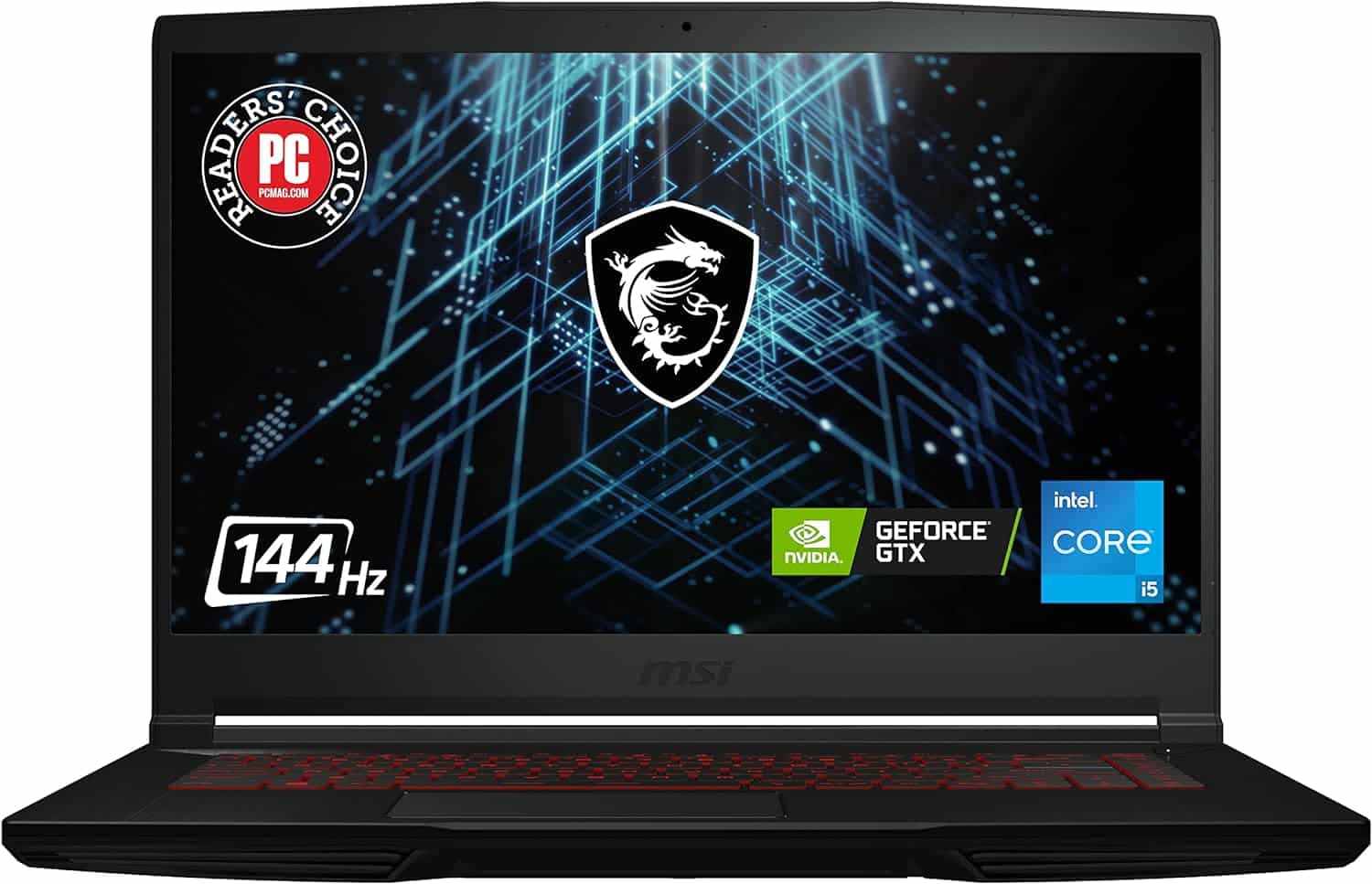
Intel Core i5-12450H
8GB RAM DDR4
2050 RTX 4GB vRAM
1TB PCIe SSD
15” 1080p IPS 60Hz
4.1 lbs
2 hours
Alright, let’s be real—this laptop is packing all the power you’ll ever need for Photoshop. It’s got the hardware to crush big edits, and unless you’re trying to render a Marvel movie, anything more is just throwing cash away. Here’s why this thing slaps for creatives on a budget.
CPU: Core i5-12450H vs the Rest
This i5-12450H is an “H”-series chip, which basically means it’s built to handle heavier stuff like gaming and content creation. Photoshop lives in that sweet spot where you don’t need a monster CPU, but you also don’t want something weak like those “U” or “P” chips.
If you’re doing big projects—like 100-layer files, high-res edits, or chonky neural filters—this CPU speeds up everything from zooming to running effects. And yeah, you could go for a Core i7 or Ryzen 7, but for Photoshop, it’s just extra. This i5 is all you need.
GPU: RTX 2050 with 4GB vRAM
Here’s where it gets spicy. The RTX 2050 might feel like overkill for Photoshop, but it’s not. If you’re working on big canvases, zooming in to pixel-perfect levels, or running GPU-accelerated filters (like Smart Sharpen or Blur Gallery), this thing handles it like a champ.
Compared to integrated graphics (like Intel Xe or Vega 7), the dedicated GPU makes a huge difference when things get heavy. And if you’re dabbling in other creative software—like After Effects for motion graphics or Lightroom for photo editing—the RTX 2050 really starts to pay off.
But do you need anything more than this, like a 3050 or 3060? Nope. For Photoshop, the extra CUDA cores and vRAM won’t make much of a difference. Save your money unless you’re also gaming or doing 3D modeling.
Updated for 2025: Do You Really Need the Newest Stuff?
- CPU: Intel 14th-gen chips? Nice for power efficiency, but for Photoshop, they’re basically the same as this i5-12450H.
- GPU: RTX 3050 Ti or Intel Arc GPUs? Cool, but they’re stuck in laptops that cost $800+. The RTX 2050 hits the sweet spot for Photoshop under $600.
Display: FHD IPS Panel
Alright, so it’s not a QHD display, but for 1080p IPS, it’s solid. You’ll get sharp visuals and decent color accuracy. If you’re hardcore about color grading, you might want to calibrate it or hook it up to an external monitor, but for most people, this is more than good enough.
Storage & RAM
- RAM: 8GB is fine for Photoshop, but let’s not pretend it’s ideal. If you’re working on super heavy projects, you might hit some slowdowns. Luckily, this laptop is upgradeable, so you can bump it up to 16GB or even 32GB.
- Storage: 1TB SSD? Hell yeah. That’s plenty for project files, RAW images, and whatever else you’re hoarding.
Portability: Manageable, But Don’t Expect Ultrabook Vibes
At 4.1 lbs, it’s not super heavy, but it’s not feather-light either. The real drawback is the 2-hour battery life—this thing loves to hug an outlet. Definitely more of a “desk setup” machine than something you’d take to a coffee shop for hours.
3. MacBook M4 Pro Chip
Best Mac For Photoshop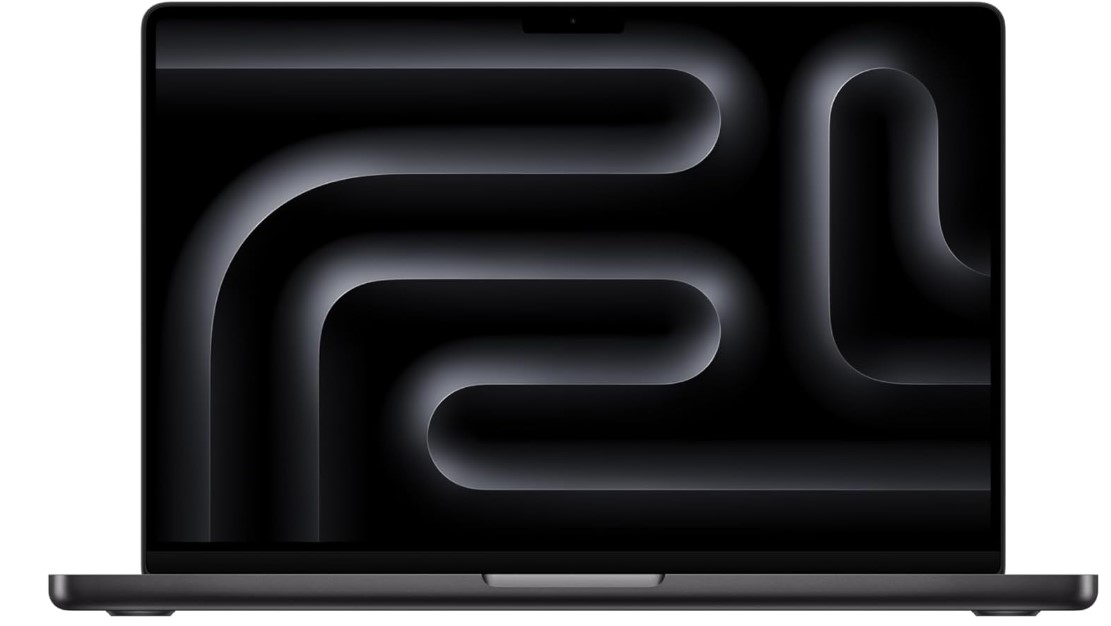
M4 12 Core CPU
24 GB Unified Memory
16‑core GPU
512GB-2TB SSD
14.2-16 inch Liquid Retina XDR display 3024-by-1964
4.7lb
13 hours
MacBooks have always been a go-to for creatives, and the MacBook Pro M4 is no exception. It’s designed for professionals who need serious power and a seamless workflow. If you’re working in Photoshop, this laptop is like having a supercharged creative assistant—speed, precision, and insane color accuracy all rolled into one.
But does it justify the premium price tag? Let’s break it down.
The MacBook Advantage: Why Creatives Love Them
macOS is built for creators. The operating system is optimized for apps like Photoshop, Lightroom, and Illustrator. Everything runs smoothly, with no hiccups, and the app integration is flawless. If you’re juggling multiple creative tools, the Mac ecosystem (hello, AirDrop and iCloud) keeps your workflow ridiculously efficient.
Color Accuracy & Gamut: MacBooks are known for their industry-leading displays, and the Liquid Retina XDR takes it to the next level. With a P3 wide color gamut and 1,000 nits sustained brightness (1,600 peak), you’re seeing colors exactly as they’re meant to be seen. Whether you’re editing RAW photos, adjusting intricate details, or doing color grading, this display ensures absolute precision.
Build Quality: It’s a MacBook. The unibody aluminum design, responsive trackpad, and excellent keyboard all scream premium. It’s not just a tool; it’s a statement.
M4 Chip: Built Different
The M4 chip is Apple’s latest, and it’s an absolute powerhouse. It’s got a 12-core CPU and 18-core GPU, with 16GB of unified memory. Unlike traditional laptops where the CPU and GPU memory are separate, Apple’s unified memory architecture lets the entire system share the same pool of high-speed memory. Translation? Photoshop runs like a dream.
You can have multiple massive projects open, use neural filters, and apply GPU-accelerated effects without even making this thing break a sweat. If you’ve been frustrated with lag on other laptops, you’ll love how responsive the M4 feels, even with the most demanding workflows.
GPU Power: How Does It Compare?
The 18-core GPU in the M4 chip is tuned for creative workloads. While it’s not directly comparable to something like an RTX 3060 or 3070 in gaming laptops, its real-world performance in Photoshop and other creative apps is phenomenal.
GPU-accelerated tasks, like running Smart Sharpen, applying Blur Gallery effects, or using 3D tools, are lightning-fast. And it’s not just Photoshop—the GPU flexes in other apps too. If you’re dabbling in After Effects, Final Cut Pro, or Blender, the M4’s GPU performance makes it feel like a desktop workstation.
Display: Liquid Retina XDR
This 16.2-inch display is what truly sets the MacBook Pro apart. With a 3456 x 2234 resolution, it’s sharper than most laptops on the market. The P3 color gamut and Extreme Dynamic Range (XDR) make colors pop like you’re working on a high-end reference monitor.
For Photoshop, this means you can trust what you’re seeing on the screen. Every color adjustment, gradient, and texture detail looks exactly as it should. The extra screen real estate also means more space for your tools and layers, reducing the need for constant zooming or switching between panels.
Storage & RAM: Future-Proofed
- RAM: 16GB of unified memory is more than enough for Photoshop, especially with the M4’s memory architecture. It’s not upgradeable, but honestly, you won’t need to upgrade unless you’re editing gigapixel images or running super-complex 3D files alongside Photoshop.
- Storage: The 512GB SSD is lightning-fast. File transfers, loading projects, and even booting up macOS happen instantly. If you need more storage, external Thunderbolt 4 drives work seamlessly.
Portability: Heavy but Long-Lasting
At 4.7 lbs, this isn’t the lightest laptop, but it’s manageable for a 16-inch machine. The 12+ hours of battery life is incredible for something this powerful. You can go a full workday editing and still have juice left for Netflix after.
Final Thoughts
The MacBook Pro M4 is the ultimate Photoshop machine for professionals who demand precision, speed, and reliability. Its Liquid Retina XDR display, M4 chip, and macOS optimization make it a dream for photo editing and other creative tasks.
Is it expensive? Yeah, no doubt. But if you’re someone who values a flawless creative workflow, amazing color accuracy, and unmatched build quality, this is worth every penny.
TL;DR: If you’re serious about Photoshop (and other creative software), the MacBook Pro M4 is the gold standard. It’s pricey, but for what you’re getting, it’s absolutely worth it.
4. Acer Aspire 5
Best Cheap Laptop For Adobe Photoshop
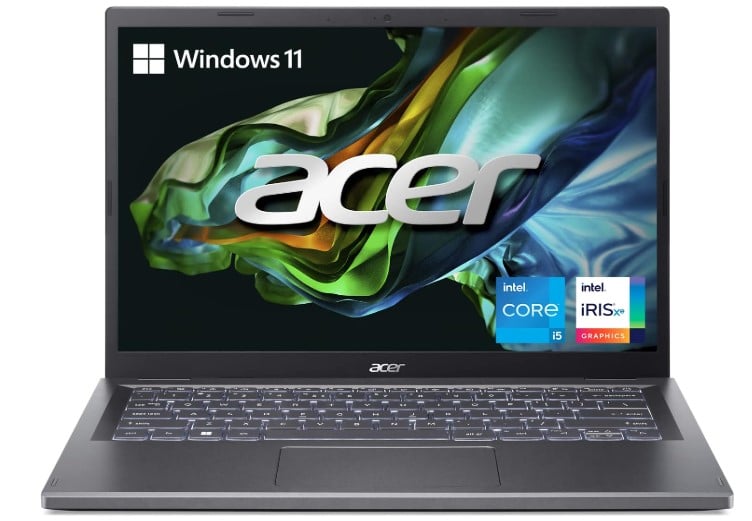
Core i5-1335U
8GB LPDDR5
Radeon Vega RX 7
512GB SSD NVMe PCIe 4.0
15.6” FHD
3.7 lbs
8 hours
This laptop isn’t the bare minimum to run Photoshop—that would be something like a Core i3 or Ryzen 3. Instead, it’s a budget-friendly laptop with significantly more power, making it ideal for Photoshop workflows without blowing your budget.
At just $410, this is the best value laptop I’ve found with this hardware configuration for 2025. Let’s break down why it’s a great choice for Photoshop users:
CPU: Core i5-1335U vs Ryzen 5 7520U
This laptop packs a 13th-gen Intel Core i5-1335U, which is one of the best CPUs in the budget category. Even though Intel’s 14th-gen processors are starting to roll out, they’re either unavailable or way more expensive.
Photoshop is primarily single-threaded, which means the Core i5-1335U shines compared to the Ryzen 5 7520U, its closest competitor. In single-core benchmarks, the i5-1335U is faster, so tasks like applying filters, using Content-Aware Fill, or editing high-res images feel snappier on this machine.
The DDR5 RAM also gives a slight edge in performance compared to older DDR4 systems. While it’s not a massive leap, it helps minimize delays when working with heavy effects or large files.
GPU: Intel Xe Graphics
Photoshop doesn’t require a dedicated GPU, but having strong integrated graphics is a major plus for GPU-accelerated features. This laptop comes with Intel Xe Graphics, which performs closer to entry-level dedicated GPUs and outpaces AMD’s RX Vega 7 in this price range.
For Photoshop, this means smoother performance when using GPU-accelerated tools like Smart Sharpen, Blur Gallery, and Select and Mask. It also handles complex tasks like working with high-res images or zooming and panning on large canvases without stutter.
While AMD might release 8th-gen Ryzen chips later in 2025, for now, Intel Xe Graphics is the better choice for budget Photoshop users.
Storage & RAM: 512GB SSD + 8GB RAM (Expandable)
This laptop doesn’t cut corners where it counts. It includes:
- 512GB PCIe 4.0 SSD: This is a big upgrade from the 256GB SSDs you typically see in laptops under $500. It’s fast, spacious, and gives you plenty of room for your projects, RAW files, and creative software.
- 8GB DDR5 RAM: While 8GB is enough for most Photoshop tasks, it’s upgradeable. Adding another 8GB to hit 16GB is worth considering if you frequently work with multiple large files or heavy layers.
Having upgradeable storage and RAM is a big win for future-proofing. You’re not locked into the base specs, which is great for growing needs.
Display: 15.6” FHD IPS
The 15.6-inch FHD display is solid for this price. It delivers sharp visuals and decent color accuracy. While it doesn’t have the wide color gamut or brightness of high-end displays, it’s more than good enough for most Photoshop users, especially beginners or those on a budget.
If you’re doing critical color work, you might want to calibrate the screen or invest in an external monitor later. But for everyday editing, this display gets the job done.
Portability: Light and Long-Lasting
At 3.7 lbs, this laptop is easy to carry around, whether you’re working from home, a coffee shop, or on campus. The 8-hour battery life is another plus, making it a reliable option for working on the go.
Final Thoughts
At $410, the Acer Aspire 5 offers insane value for Photoshop users. With a 13th-gen Core i5, Intel Xe Graphics, and 512GB SSD, it’s a powerful and budget-friendly option that handles most Photoshop workflows with ease.
While it doesn’t have the bells and whistles of premium laptops, like high-res displays or dedicated GPUs, it delivers reliable performance for photo editing, even with large files and heavy layers. The ability to upgrade the RAM and storage makes it a solid investment for the long term.
TL;DR: If you’re looking for a budget Photoshop laptop that won’t hold you back, the Acer Aspire 5 is hands-down the best choice in 2025.
5. ASUS TUF Gaming F17
BEST 17 inch Laptop For Adobe Photoshop
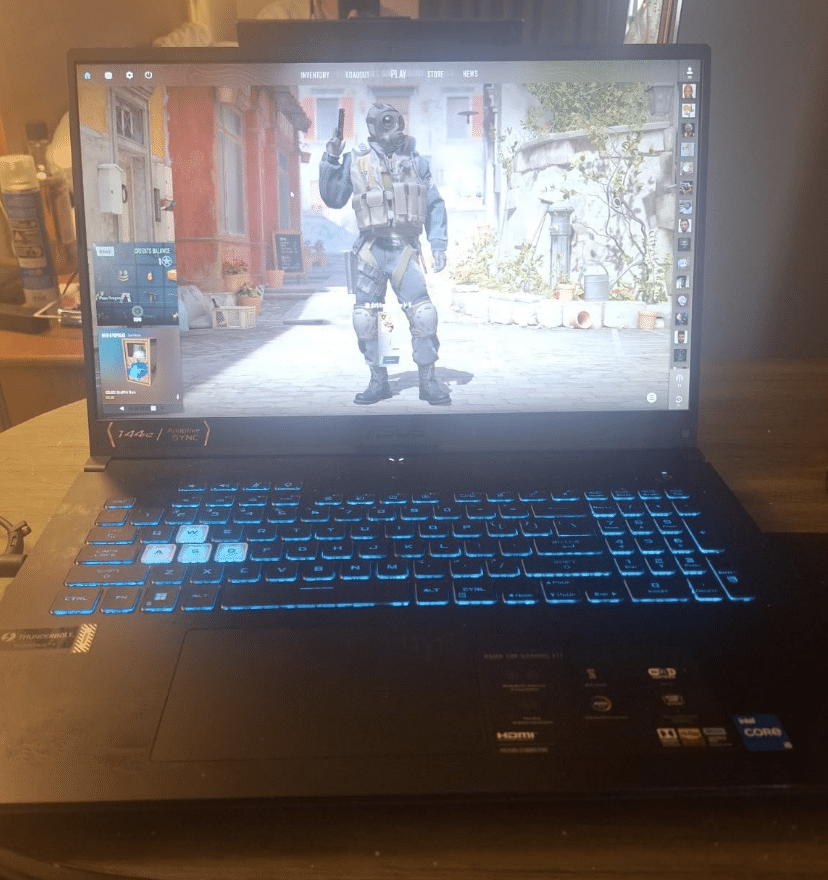
Core i5-12500H
16GB DDR4
RTX 3050 4GB vRAM
512GB PCIe NVMe SSD
17.3″ FHD 144Hz IPS
7.1lbs
2 hours (when using GPU)
Lastly a gaming laptop for Adobe Illustrator. Unlike all laptops on this list, this has the biggest display.
By now, you’re probably thinking, “Another dedicated GPU for Photoshop? Is this even necessary?” And yeah, we’ve already covered that Photoshop doesn’t demand a super-powerful GPU. But this isn’t just about scraping by—it’s about turning up the dial on multitasking, GPU-accelerated effects, and future-proofing your setup.
Let’s not waste time rehashing the basics of GPUs or why Photoshop isn’t exactly a 3D modeling monster. Instead, let’s dive into what makes this ASUS TUF Gaming F17 a compelling choice—and where it stands out.
The Display: A True Game-Changer for Creatives
Here’s where this laptop really flexes: the 17.3-inch FHD display. If you’re tired of cramming all your Photoshop panels, tools, and layers onto a tiny 15-inch screen, this thing is like upgrading from a bike to a truck.
Sure, it’s “only” FHD and not QHD, but the sheer size of the screen makes up for it. You’ve got space for your canvas, reference images, and even an open browser for tutorials or stock photos—all without feeling claustrophobic.
Would a QHD display have been better? Absolutely. But let’s be real, that’s usually locked behind a paywall reserved for laptops costing twice as much.
RTX 3050: More Than You Probably Need, but Nice to Have
Okay, let’s address the obvious: the RTX 3050 is overkill for Photoshop. You’re not rendering 3D models or running AAA games at ultra settings here. But where it does shine is in multitasking and GPU-accelerated features. If you’re the kind of person who works on big, high-res projects with tons of layers and uses tools like Blur Gallery or Select and Mask, this GPU makes everything snappier.
And if you dabble in other apps—like After Effects for motion graphics or Premiere Pro for video editing—the RTX 3050 starts to feel less “overkill” and more “just right.” Think of it as a bonus feature for when your creative projects extend beyond Photoshop.
Specs That Work Without Fuss
The Core i5-12500H is a beast for CPU-heavy tasks like Content-Aware Fill or exporting large files. Pair that with 16GB of RAM, and you’ve got a system that can handle complex projects without breaking a sweat.
Storage? 512GB of SSD space is plenty for Photoshop files, and the extra upgrade slots mean you’re not locked into this setup forever. Add more RAM or throw in another SSD later—it’s all easy to do.
The Trade-Offs: Weight and Battery Life
At 7.1 lbs, this is not the laptop you casually toss into your backpack for a day out. It’s heavy, bulky, and more at home on a desk than on the go. The 2-hour battery life (with the GPU running) isn’t winning any awards either, so keep that charger handy.
But for a 17-inch laptop, portability isn’t really the point. This is a workhorse designed to stay plugged in and power through big projects.
Who’s It For?
If you’re all about Photoshop and only Photoshop, you might be better off with a lighter, smaller laptop with integrated graphics (you’ve seen those options in earlier reviews). But if you’re working across multiple creative apps, or you just want a big screen to spread out your workflow, this machine is perfect.
Final Thoughts
The ASUS TUF Gaming F17 is a niche choice for Photoshop users—ideal for those who value a huge display, plenty of upgrade options, and a GPU that can handle more than you’ll probably throw at it. It’s not for everyone, but if you’re looking for a powerful, future-proof setup that doubles as a multitasking beast, this laptop’s got your back.
TL;DR: Overkill for Photoshop alone, but perfect if you need a big screen and extra GPU power for other creative apps. Just don’t plan on carrying it around all day.
How To Buy The Best Laptop For Photoshop
The best place to start is with the official hardware requirements for Photoshop, which are as follows:
| Category | Requirement |
|---|---|
| Display | 1024 x 768 resolution |
| CPU | 2 GHz processor |
| RAM | 8GB |
| GPU | 512MB VRAM |
| Storage | 3GB of free space |
At first glance, these specs might seem laughable compared to what’s available in modern laptops. Any device above $350 will likely exceed these minimums (except perhaps the GPU requirements). However, if you dip below $300, you’re venturing into territory where performance will be so sluggish that it might make you reconsider using Photoshop altogether.
Here’s a simple rule of thumb: prioritize RAM above everything else. GPU will only come in handy with much more complex projects that only a few photoshop users get into.
Recommended Specs For Photoshop
When it comes to Photoshop, getting the latest and most expensive CPU doesn’t necessarily mean better performance. Here’s why:
1. CPU
Most operations in Photoshop are single-threaded, meaning they use only one core of your CPU. Features like brush strokes, layer adjustments, and basic editing tasks depend more on the clock speed (measured in GHz) rather than the number of cores. While there are some multi-threaded processes, they provide only marginal improvements beyond 6 cores.
What About Multi-Core CPUs?
Some advanced features, such as exporting files, batch processing, and Neural Filters, use multiple cores. However, for general editing, higher clock speeds are far more important than a high core count.
Benchmark studies from third-party testers, like Puget Systems, confirm:
- Single-threaded tasks dominate Photoshop workflows.
- Whether you use a dual-core or a 12-core processor, single-threaded tasks rely on whichever core has the highest clock speed.
- Multi-threaded tasks cap at 6 cores.
- Beyond 6 cores, additional cores show no noticeable performance gains.
Here’s a table of modern CPUs and their specs, tailored for Photoshop:
| CPU | Base Clock | Turbo Clock | Cores | Threads | Best For |
|---|---|---|---|---|---|
| Intel Core i3-1315U | 3.3GHz | 4.5GHz | 6 | 8 | Beginners, light editing |
| Intel Core i5-1340P | 2.4GHz | 4.6GHz | 12 | 16 | Intermediate users, photo editing |
| Intel Core i7-13700H | 2.1GHz | 5.0GHz | 14 | 20 | Advanced editing, large projects |
| Intel Core i9-13980HX | 2.2GHz | 5.6GHz | 24 | 32 | Heavy multitasking, professionals |
| AMD Ryzen 3 7330U | 2.9GHz | 4.2GHz | 6 | 12 | Beginners, casual editing |
| AMD Ryzen 5 7535HS | 3.3GHz | 4.5GHz | 6 | 12 | Intermediate editing workflows |
| AMD Ryzen 7 7735HS | 3.2GHz | 4.75GHz | 8 | 16 | Advanced photo editing |
| AMD Ryzen 9 7945HX | 3.7GHz | 5.4GHz | 16 | 32 | Professionals, multitasking |
2. RAM
If Photoshop isn’t running as smoothly as you’d like, it’s probably your RAM holding you back. RAM is where all the magic happens—it’s the workspace where Photoshop stores the data it’s actively working on. When you run out of RAM, Photoshop has to dip into your storage (scratch disk), which is painfully slower. So yeah, don’t sleep on RAM.
How Much RAM Do You Actually Need?
If your current laptop feels laggy with Photoshop, chances are it doesn’t have enough RAM. Before you panic and rush to buy a new laptop, try upgrading your RAM first—it’s way cheaper and can make a night-and-day difference.
How to Check Your Current RAM Usage:
- Open Photoshop and every program you usually run with it (e.g., Chrome, Illustrator, Office).
- Press CTRL+ALT+DEL (or open Task Manager).
- Look at how much RAM your system is using.
- Add 4GB to whatever number you see. That’s your sweet spot.
8GB vs. 16GB (The Great Debate)
Here’s the deal:
- 8GB: Totally fine for light to moderate editing. If you’re just working on smaller files with a few layers, 8GB will do the job.
- 16GB: If you’re diving into serious multitasking (Photoshop + 10 Chrome tabs + Illustrator), or if you’re editing large, high-res images with tons of layers, 16GB is a must.
What About More Than 16GB?
- Honestly, 32GB+ is overkill for 99% of Photoshop users.
- Unless you’re working with huge files (e.g., 8K images, hundreds of layers) or doing heavy video editing, you won’t feel the difference beyond 16GB.
DDR4 vs. DDR5: Does It Matter?
By now, most laptops are switching from DDR4 (older RAM tech) to DDR5. Here’s what you need to know:
- DDR5: Faster data transfer speeds (up to 6400MHz vs. DDR4’s 3200MHz). This can help with smoother performance when handling large files or running multiple apps simultaneously.
- Does Photoshop Need DDR5? If you’re working on massive projects or using AI-based tools like Neural Filters, DDR5 might give you a slight edge. Otherwise, DDR4 is still perfectly fine for Photoshop.
Budget Tip:
If you’re choosing between 16GB DDR4 and 8GB DDR5, go with the higher capacity (16GB). Capacity > speed for Photoshop.
Can You Upgrade RAM Later?
The good news: Most laptops that come with 8GB RAM allow you to upgrade to 16GB or even 32GB later. If you’re on a budget, start with 8GB, but make sure your laptop has an upgradeable RAM slot.
3. Storage
Why Storage Speed Matters
Photoshop relies on your storage drive for:
- Opening and saving large files.
- Acting as a scratch disk when RAM is full.
Types of Storage
- HDD (Hard Disk Drive): Outdated and too slow for Photoshop. Avoid it.
- SATA SSD: Decent speed, but not ideal for heavy workflows.
- PCIe NVMe SSD (3.0/4.0/5.0): Blazing fast, especially for scratch disks and large file operations.
3.1 PCIe NVMe 5.0 SSDs
These drives are 2x faster than PCIe 4.0 and can significantly improve performance for:
- Saving or loading large multi-gigabyte files.
- Using scratch disk operations for 4K or higher resolution projects.
3.2 Recommended Storage Capacities
- 128GB SSD: Too small, even for light use. Avoid.
- 256GB SSD: Okay for basic users with cloud storage.
- 512GB–1TB SSD: Ideal for photographers and advanced users.
4. Display
When it comes to Photoshop, your display isn’t just a screen—it’s your creative workspace. While it might not seem as critical as your CPU or RAM, a good display can make a world of difference, especially for color-sensitive work like photo editing or graphic design.
Depending on what kind of Photoshop user you are, different display features will matter more. Let’s break it down.
Resolution: How Much Workspace Do You Need?
It might seem obvious that a bigger display gives you a larger workspace, but the resolution plays an even bigger role. A high-resolution display allows your computer to fit more icons, toolbars, and panels on the screen, all while keeping everything sharp and easy to see.
Resolution Options
- 1080p (Full HD):
This is the minimum resolution you should aim for, and most laptops above $500 come with this as standard. It’s fine for beginners or budget users but can feel cramped for larger projects.
- Best For: Basic editing, general use.
- 1440p (Quad HD):
Offers significantly more screen space for multitasking. You’ll have enough room to keep all your tools visible without constantly switching between panels.
- Best For: Intermediate users, multitasking.
- 4K (Ultra HD):
Perfect for professionals working on high-detail projects, 4K gives you the sharpest images and most workspace. However, it’s more expensive, and the high resolution can drain battery life on laptops. - Best For: Professionals, detailed photo editing, or work targeting high-resolution devices like 4K monitors or iPhones.
Why Resolution Matters
If you frequently work with Photoshop’s complex tools and large canvases, higher resolutions (1440p or 4K) will save you time by reducing the need to scroll or zoom in and out.
Color Gamut: Accuracy Matters for Pros
The color gamut refers to the range of colors a display can reproduce. Different projects require different levels of color accuracy. Here are the two most common standards:
sRGB (Standard RGB):
- Covers the range of colors seen on most monitors and web displays.
- Best For: Web designers, bloggers, or anyone creating content primarily for online use.
AdobeRGB
- Covers a wider range of colors, especially greens and blues, which are essential for high-quality printing.
- Best For: Professional photographers, print designers, and anyone working on high-end publishing or print media.
When Does Color Gamut Matter?
- If your work involves printing images, an AdobeRGB display ensures what you see on screen matches the printed output.
- For online content, 100% sRGB is sufficient, as most devices (phones, monitors, etc.) are calibrated to this standard.
If you need a good reference, check this world’s expert take on gamut.
Example:
- Instagram Photo: A 100% sRGB display is perfect.
- Magazine Cover: A 99% AdobeRGB display is essential for accurate color matching.
Panel Types: IPS vs. TN
Your display’s panel type affects color accuracy, viewing angles, and overall image quality. Here’s what you need to know:
IPS (In-Plane Switching):
- Pros: Superior color accuracy, wider viewing angles, and consistent brightness across the screen.
- Cons: Slightly more expensive.
- Best For: Photoshop users, graphic designers, and photographers.
TN (Twisted Nematic):
- Pros: Cheaper.
- Cons: Poor color reproduction and narrow viewing angles.
- Best For: Avoid these if you’re doing creative work.
Glossy vs. Matte Displays
Glossy Displays
- Pros: Better color vibrancy, making them ideal for color-critical work in controlled environments.
- Cons: Reflective and prone to glare, which can be annoying if you work near bright light sources.
Matte Displays
- Pros: Reduce glare, making them better for bright environments like offices or near windows.
- Cons: Slightly duller colors compared to glossy screens.
External Monitors: An Upgrade for Serious Work
If you’re serious about Photoshop, consider adding an external monitor to your setup. These provide more screen space and better color accuracy than most laptop displays.
Example
A 27” 4K monitor with 99% AdobeRGB coverage is perfect for professionals needing precise color matching.
Recommended Display Specs for Photoshop (2025)
| Feature | Recommendation |
|---|---|
| Resolution | 1080p (minimum), 1440p or 4K preferred |
| Color Gamut | 100% sRGB (web), 99% AdobeRGB (print) |
| Panel Type | IPS (avoid TN panels) |
| Size | 15.6” (laptops), 24”+ (external monitors) |
| Finish | Glossy for color accuracy, Matte for glare reduction |
5. GPU (Graphics Card)
Photoshop primarily relies on your CPU for most tasks, but a GPU (graphics card) can speed up certain processes. If you work with high-res files, AI features, or GPU-accelerated effects, having a good GPU is crucial. However, it’s not as important as the CPU and RAM for most users.
5.1 What Does the GPU Do in Photoshop?
The GPU accelerates tasks that involve rendering, real-time effects, and high-resolution processing. Here’s what the GPU helps with:
- Neural Filters: AI-powered tools for skin smoothing, style transfers, and background blur.
- Liquify Tool: Warp and reshape images in real time with no lag.
- Camera Raw Filters: Accelerated adjustments like noise reduction and color grading.
- 3D Rendering: Creating or manipulating 3D objects within Photoshop.
- Image Navigation: Zooming, panning, and rotating large images become smoother on a GPU.
Without a dedicated GPU, these tasks will run slower or lag, especially with larger files.
5.2 Understanding GPU Cores
GPU cores (often called CUDA cores for NVIDIA or Stream Processors for AMD) are parallel processors that handle complex calculations simultaneously.
- More cores = better performance for GPU-intensive tasks like Neural Filters and 3D rendering.
- However, Photoshop doesn’t use all the GPU cores for every task. So, while having more cores helps, there’s a point of diminishing returns.
Example:
- An NVIDIA RTX 3050 with 2048 CUDA cores will handle Photoshop smoothly for most users.
- An NVIDIA RTX 4070 with 4608 CUDA cores will excel in heavy 3D rendering and advanced AI tasks.
For most Photoshop users, the 3050 or 4060 will strike a good balance between price and performance.
5.3 Dedicated vs. Integrated GPUs
- Integrated GPUs: Built into the CPU, like Intel Iris Xe or AMD Radeon Vega. Suitable for light Photoshop use.
- Dedicated GPUs: Standalone graphics cards (e.g., NVIDIA RTX or AMD Radeon RX). Recommended for intermediate to professional users.
5.4 How Much VRAM Do You Need?
VRAM (Video RAM) is the memory your GPU uses to process visual data.
- 4GB VRAM: Enough for most Photoshop tasks, including high-res photo editing.
- 6GB VRAM: Great for multitasking or using dual monitors.
- 8GB+ VRAM: Best for professionals working with massive files or 3D content.
Examples:
- A 3000x2000px image with several layers will work fine on a GPU with 4GB VRAM.
- A 10,000×10,000px image with dozens of layers will need 6GB or more for smooth performance.
5.5 Recommended GPUs for Photoshop (2025)
| GPU | VRAM | Best For |
|---|---|---|
| NVIDIA GTX 1650 | 4GB | Entry-level, basic GPU-accelerated effects |
| NVIDIA RTX 3050 | 4GB | Intermediate users, AI tools, Camera Raw |
| NVIDIA RTX 4060 | 8GB | Advanced users, dual monitors, large projects |
| NVIDIA RTX 4070 | 8GB | Professionals, 3D rendering, complex workflows |
| AMD Radeon RX 7600M | 8GB | Intermediate to advanced Photoshop use |
5.6 When Do You Need a High-End GPU?
- You Work on Large Projects Regularly: Files with hundreds of layers or large dimensions (e.g., 8K resolution) will benefit from a GPU with more VRAM.
- You Use 3D Features or Neural Filters: High-end GPUs with more cores accelerate these effects.
- You Use Multiple Monitors: A GPU with 6GB+ VRAM ensures smooth performance across multiple displays.
Budget Tip:
For most Photoshop users, a mid-range GPU like the RTX 3050 or 4060 is more than enough. Save the high-end GPUs (RTX 4070+) for heavy 3D work or professional video editing.
Comments?
If you have any questions or suggestions, please let us know in the comments below.
Author Profile
- I am physicist and electrical engineer. My knowledge in computer software and hardware stems for my years spent doing research in optics and photonics devices and running simulations through various programming languages. My goal was to work for the quantum computing research team at IBM but Im now working with Astrophysical Simulations through Python. Most of the science related posts are written by me, the rest have different authors but I edited the final versions to fit the site's format.
Latest entries
 wowDecember 18, 20255 Best Laptops For World of Warcraft – Midnight & Classic (2026)
wowDecember 18, 20255 Best Laptops For World of Warcraft – Midnight & Classic (2026)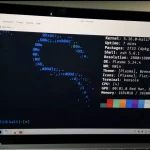 LaptopsDecember 17, 2025The 4 Best Laptops For Virtualization of 2026 (10-50 VMs ATSM)
LaptopsDecember 17, 2025The 4 Best Laptops For Virtualization of 2026 (10-50 VMs ATSM) Hardware GuideDecember 17, 20252026 Beginner Guide to Reading Computer (Laptop) Specifications
Hardware GuideDecember 17, 20252026 Beginner Guide to Reading Computer (Laptop) Specifications LaptopsJune 30, 2025Best Laptops for Computer Science (July 2025 )
LaptopsJune 30, 2025Best Laptops for Computer Science (July 2025 )
